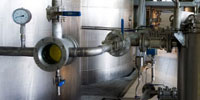Harvesting, transport, the separation of leaves and washing
The olives are harvested from the olive trees between late autumn and early winter. It is a major agricultural task which has a direct influence on the composition of the oil and its sensory characteristics.The olives are cleaned and sieved, removing debris such as leaves, stems, earth and small stones. They are then washed in cold water to remove other impurities such as dust, mud and possible traces of herbicides. They are finally stored on small piles, waiting to be ground.
Grinding and crushing
The crushing of the olives is the first process they undergo. This entails breaking up the fruits so that they can later release the oil they carry within their cells.
The olives are introduced in an automated manner into hammer mills, normally with a horizontal axis, and hit by the metallic hammers which rotate at a high speed. The mill has a sieve of a given diameter; when the particles reach it they pass through or, if not, they stay inside the mill until they do.


 English
English Español
Español  Français
Français 



